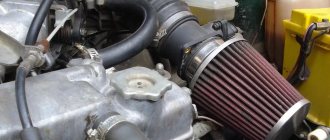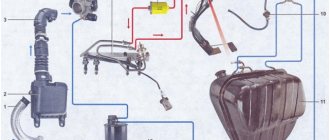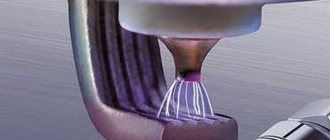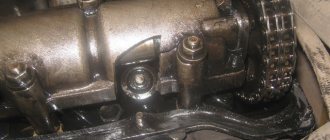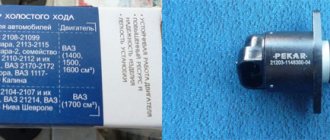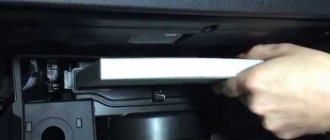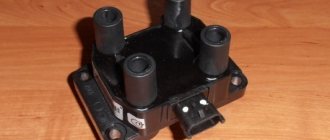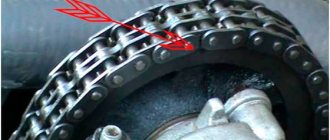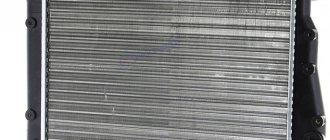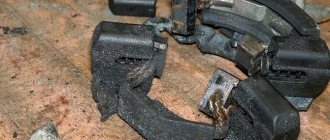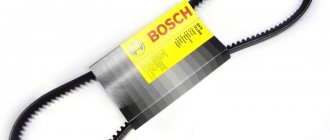Why is such a filter needed in an engine?
It is believed that the zero filter increases engine power. This is true and noticeable on powerful racing cars such as Formula 1, but does it make sense to install it on a simple car such as a Renault Duster?
Let's try to figure out what a zero-resistance filter actually does. Its main task, like any other similar device, is to clean the air entering the fuel system. Thanks to this, midges, dust and other contaminants do not get into the engine, fuel mixture, injector and carburetor of the car. By using a filter, the service life of the motor increases up to 10 times, since it prevents sand and other harmful solid particles from getting inside, which can cause damage to the mechanism.
What's wrong with a standard filter?
The zero resistance filter has quite opposite reviews. Before deciding whether to install it on your car or not, you should study the advantages and disadvantages of this type. Unlike a standard element, whose resistance coefficient is about 7%, a zero element has almost no such resistance. This value is close to zero. What does it mean? In simple terms, the nulevik is made of another paper or other material; it does not create resistance when the motor is running, that is, the power is directed to operating the engine, and not overcoming some obstacles in order to force the air mixture to move.
The lack of resistance is good, but you have to pay for it with the poor filtering ability of the element, which is why the motor gets dirty much faster. This is the main disadvantage of a zero filter: it is not able to protect the internal systems of the car from small solid particles, such as grains of sand and solid impurities.
Zero resistance
The throughput of such a device is much higher, so the nulevik allows you to increase engine power without significantly affecting fuel consumption. A special feature of the structure is large pores and a minimal amount of paper in the structure. The zero-resistance air filter retains almost no air. As a rule, cotton fabric and aluminum screen are used as the base.
Pros and cons of zero
Having familiarized yourself with the design and differences between the factory paper filter and the zero filter, you can confidently name the advantages of the second:
- Thanks to its complex design, the nulevik provides low resistance without compromising cleaning quality, protecting the intake system from debris and the engine from wear.
- The fabric configuration allows you not to change the filter every 10 thousand km. It is enough to simply renew the impregnation and rinse the element.
- After replacing the unit, the motorist will receive several additional horsepower. More likely, there will be an increase in torque at mid and low speeds.
However, like any upgrade, tuning the power unit using a modern filter also has its drawbacks:
- To obtain an actual increase in torque, you will have to perform several additional operations: remove the standard element along with the liner and install a cone zero on the mass flow sensor or on its pipe.
- It makes no sense to install a filter on an engine with a volume of up to 1.8–2 liters. The increase in power will be no more than 5 horsepower, and physically even the most experienced driver will not be able to feel it.
Varieties
The k&n zero resistance filter can be of several types. The following device types are distinguished:
- Without impregnation: it is called a dry filter. It is similar to the standard one, but the pores are larger, so the increase in engine power can be up to 5%, depending on the initial engine performance. This will only be noticeable on very powerful cars.
- With impregnation. It is the most effective, but the cost of such consumables is higher than usual. It is made of fabric and impregnated with a special oil composition, which helps purify the air of small particles. Dust sticks to the impregnation and does not pass further. At the same time, the filter does not interfere with engine operation and allows you to increase its power by 7%.
The second type is more popular, but requires maintenance and needs to be cleaned and re-lubricated regularly.
Why is the regular one so bad?
Again, everything is simple - as you and I know, an internal combustion unit has only 4 strokes, these are intake, compression, ignition, and exhaust gases. The engine, on the intake stroke, sucks the air-fuel mixture into the engine cylinders; if gasoline flows through its own line, then air is sucked in from the environment. If there were no filter, it would be sucked in with everything that came across (midges, dust, etc.), but the filter protects against this - however, it is a kind of plug that prevents the air from passing through normally, that is, resistance is encountered.
The standard filter element has a significant resistance coefficient, often taking away 5 - 7% from the engine power. This is understandable, it practically does not allow dust particles to pass through, and is made of special paper.
This element is far from ideal, it seems like everything is simple, but damn there is no solution and that’s it! Or is there?
All the advantages and disadvantages
Before installing a zero-resistance filter, it is worth studying its pros and cons, since the increase in power is not always noticeable, and dirt getting inside the cylinders will be noticeable on any car.
After testing a car on which a zero gear is installed, on a dynamometer stand you can be convinced that there is an increase in power, but in fact it is not as significant as consumables sellers promise. The fact is that this is noticeable only when the damper is fully open. On formed engines, the operation of the filter is more noticeable, but again only with increasing speed. If there is turbocharging, there will not be much difference with the standard filter.
Pros and cons: is there any sense in “nulevik”?
In reality, the difference with and without a filter is noticed only on a dynamometer stand. The benefit of reducing the resistance of only one element of the intake system appears exclusively in the “full throttle” mode at high speeds; in the standard city driving cycle, the effect of the “zero filter” is exactly zero.
Even for forced engines, reducing intake resistance gives a penny of benefit. Let's take for example a graph taken on a dyno with a Nissan Skyline ECR33, whose RB25DET engine has already moved away from the standard configuration:
The result is not bad - 250 horsepower at the wheels. But, if we remove the air filter altogether - to ensure a reduction in intake resistance even greater than that of a high-quality "zero" - we will get the second graph:
The drop in power after the 5000 rpm peak has become smoother, but the difference in numbers is negligible: its increase without a filter is only 8 horsepower. With 250 hp, which is already there, it is impossible to notice anywhere except on the track, when hundredths of a second count.
And you have to pay for these pennies by complicating maintenance and deteriorating air purification.
In addition, the oil impregnation of “zero” vehicles itself can cause problems on engines equipped with mass fuel flow sensors. The air flow, passing through the filter, carries along microparticles of oil, which then settle on the walls of the inlet pipes and directly on the surface of the sensing element of the mass air flow sensor. Because of this layer, which acts as a heat insulator, the mass air flow sensor begins to “lie”, giving an incorrect signal to the injection computer. And here, based on the “outdated” composition of the air-fuel mixture, the conversation will not be about a microscopic increase in peak power, but about a noticeable drop.
In some cases, the installation of the Federal Tax Service itself can even reduce the maximum engine power. When installing a fashionable cotton “cone” or a foam “mushroom”, you have to dismantle the standard air filter box and air intake. If the layout of the engine compartment is unsuccessful, after this “anti-tuning” the engine does not receive air that is close to atmospheric temperature, but air that is already heated, passing through the radiator. An increase in air temperature for every 10 degrees Celsius gives a loss in density of 0.04 kg/m3 - and an average atmospheric two-liter engine, revved up to 5000 rpm, drives 35 - 40 cubic meters through itself per minute! As a result, an engine with a zero-resistance air filter receives less air mass than with a standard, supposedly “stifled” intake.
An inevitable harm from using zero air filters is accelerated wear of the cylinder-piston group. Even the air purification results of these filters declared by the world's leading manufacturers (for example, K&N) do not exceed 99% under ideal conditions and using expensive branded impregnation oil. The paper curtain air filter is capable of filtering out 99.5 to 99.9 percent of dust. It would seem that the difference is small - but after several tens of thousands of kilometers we will already be talking about the difference in whole grams of dust that gets into the engine cylinders. Moreover, as the paper filter gets dirty, it only increases the degree of filtration: dust, clogging the pores, reduces the flow area, and they become capable of trapping smaller particles, although at the cost of increasing resistance.
In “zero” filters, contamination on the surface of the pores reduces the likelihood of new particles adhering, and the cross section of the pores remains larger than the size of the filtered particles; as contamination increases, the degree of purification decreases with little change in resistance. Previously used contact-oil air filters suffered from the same thing, where oil soaked the fishing line stuffed inside (designs familiar, for example, from old Soviet trucks and motorcycles). “Nuleviks” have become a more compact and lighter version of these filters, which have long been replaced by paper filters.
And errors during filter maintenance only increase the wear rate. Some people manage not to saturate the filters, while others use cheap aerosols or oils that are completely unsuitable for impregnation. Try rubbing a drop of the brand's impregnation oil between your fingers: it's so sticky that it's hard to even wipe it off your fingers. Other oil will not provide any noticeable improvement in cleaning compared to a filter that is not impregnated at all.
The only advantage for engines that have not undergone serious tuning from installing “nuleviks” can be considered the absence of the need for regular replacement: you need to wash and re-impregnate the same filter on time.
Installation in a car
Installing a zero-resistance filter is usually not difficult, but it all depends on which filter was chosen and what model of car you have. The procedure is no more complicated than replacing the standard engine air filter.
In some cases, a regular location can be used for installation. Sometimes it doesn’t fit and you have to install the part in another place. It’s quite easy to install a zero-resistance filter with your own hands; you just need to have enough time and desire to do it.
No staffing
The advantages of this location:
- Capable of delivering maximum power.
- They look good.
- Does not require adjustment to the existing location.
- Loss of power if the filter is close to the engine and is only able to take in thinner hot air.
Regular place
For almost any car you can purchase a zero filter suitable for installation at the factory. This greatly simplifies its installation.
- Easy installation without loss of power.
- Moving away from the heated motor.
Filter maintenance, safety and cleaning features
Once a zero gear is installed on a car, the owner will have to maintain it regularly. This should happen once every 2000-3000 km. Impregnation for a zero-resistance filter in factories is done with oil, sometimes the car owner does it himself. To do this, it is enough to lower the part into new engine oil, hold it there for a while and place it in the standard or non-standard place provided for it. However, when used, the oil becomes contaminated, dries out, and moves, so it must be changed periodically.
The nulevik is removed for this purpose; it can and should be washed. There is a special zero-resistance filter cleaner that allows you to quickly remove old oil along with remaining contaminants. To do this, the product is first cleaned with a soft brush, the option used for suede is suitable, then it is dipped into a container with a cleaner. After this, the part is washed under a weak stream of running water. Before further maintenance and installation, it must be thoroughly dried. You cannot use a hair dryer; the spare part must dry on its own at room temperature, otherwise there is a risk of its deformation, the appearance of unwanted holes, and the expansion of pores.
The fabric part must be removed and lowered into the oil again; for a zero-resistance filter, you can use a motor one. After removing the part, let the excess liquid drain, making sure that there are no dry spots left. After this, you can install everything in place.
Proper installation, use and maintenance of such a device will increase the power of the power unit, but you should carefully monitor the contamination of the consumables and service it in a timely manner. Before deciding whether it is necessary to interfere with the standard design of the car, you need to weigh the pros and cons, think about whether such a solution is suitable for your particular car, since the effect is not positive on every model. If you decide to install a zero switch, it must be done correctly, otherwise it will not give the desired effect and can cause serious harm to the fuel system and cylinders.
How does a zero resistance filter element work?
Car enthusiasts love to give their car a variety of tuning, which may not necessarily concern the exterior design, but also affect certain characteristics of the engine itself. It is believed that it is possible to increase the power of the power unit by installing an air filter, which has zero resistance. There are completely opposite opinions regarding the effectiveness of this method, so it is necessary to take into account all the pros and cons so as not to make a mistake.
The principle of operation of such an element, which affects the power system (be it a carburetor or injector) and its operation, comes down to approximately the following. Air purification is carried out by the nulevik due to the adhesion of dirt particles, while the purified air enters the cylinders unhindered. But it cannot be said that this guarantees the separation of useless particles, and that absolutely all of them will linger on the body. Much will depend on the implementation of preventive measures to care for the zero car, but drivers usually forget to adhere to this.
Air filter for VAZ 2107
From the name “air filter” it becomes clear that the device is intended for air purification. On VAZ 2107 cars, the air filter is a mandatory device that cleans the air supplied to the engine combustion chamber. If it becomes clogged, the debris will prevent air from flowing into the engine, so it is very important that the part in question in the car has always been in good condition.
An important component that can extend the service life of the engine
This is a theory. Practice says that the engines of modern cars have such a component, a part, as an air filter. Through which the air passes to form a combustible mixture in the engine. The air passing through the filter is cleaned of dust and abrasive particles. However, like any medal, this one also has a downside. And it lies in the fact that an ordinary, standard paper filter becomes an obstacle to the air flow. This leads to a drop in engine power. Not so much that it is very noticeable, but to a certain extent such a decline is present.
Relevant, first of all, for sports and forced engines.
For standard engines, such a drop is not only not scary. It may even be imperceptible. However, if, say, a car enthusiast spent money on tuning the engine of his car, preferring a sporty style and driving style, then in this case, as they say, every “horse” counts. And then the resistance of the standard air filter becomes a serious obstacle.
What is an air filter
An air filter is a device that filters the air entering the fuel system. All modern cars are equipped with air filters, including the Lada family with carburetor and injection systems.
The main purpose of the air filter is to clean the incoming air from sand, dust, soot, midges, small particles, plant seeds and other substances. The absence of the product in question will lead to the fact that all of the above-mentioned substances will enter directly into the fuel system, and after a short time it will simply be clogged.
It is important to know! All types of cars, including the VAZ 2107, must have an air filter, and it is necessary to monitor its condition and, if necessary, replace it in a timely manner.
A clogged element negatively affects engine performance, since air must pass through the device to enter the fuel system. This reduces engine power accordingly. The resistance of the product in question is quite high, but in its absence the consequences for the car will be simply catastrophic.
In a car of the classic VAZ 2107 family, the design of filters for the injection and carburetor injection systems is different. For the injector, the product in question has a rectangular shape, and on carburetor engines round-shaped filters are installed. Both types of products consist of a plastic housing and a filter element. This element is presented in the form of paper, which contains micro-pores and traps all types of small particles.
Since the creation of the part in question, many varieties have appeared. Types of air filters are divided into the following options:
- Inertial. The first products that are now used extremely rarely.
- Inertia-oil. They are also considered obsolete, so they are used extremely rarely today. Their main difference from inertial ones is the presence of oil at the bottom of the body of the product, which is intended to hold large and small particles.
- Paper. Some of the most common types are shown in the photo above.
- Products with zero resistance. Instead of a paper element, foam rubber or cotton fabric is used.
How often to change the air filter on a car
Replacing the part in question depends on the condition of the filter element. The condition of this element is influenced by factors such as the terrain in which the vehicle is operated, the frequency of operation of the vehicle, and the seasons. The VAZ-2107 injector air filter needs to be replaced somewhat less frequently than on carburetor models. In some manuals you can find a figure of 30 thousand kilometers - this is the recommended mileage for replacing the part in question. In reality, this figure does not mean anything, since the main condition for replacement is clogging of the filter element.
The part in question cannot be repaired, but if the filter elements are in good condition, that is, there is no damage and its color has not changed much. It is necessary to change the air filter because when it is clogged, fuel consumption increases. If the injection “sevens” have an on-board computer that displays an increase in consumption, then on the classics you have to rely on your memory.
Adapter for carburetor for VAZ zero-resistance injection air filter
- We guarantee fast processing of your order during business hours (we work from 11-00 to 20-00, Saturday and Sunday are days off).
- We guarantee reliable packaging of your order (when sending it by Russian Post or transport company).
- We guarantee the fastest possible dispatch of your paid order (within 2-4 business days after receipt of payment).
- We guarantee a refund or exchange for another product (with recalculation) within 14 days from the date of receipt of the order (the product must be in good condition, without traces of installation, delivery costs are not reimbursed).
- We guarantee a free exchange of goods (transportation costs at our expense) if the purchased goods turn out to be defective.
